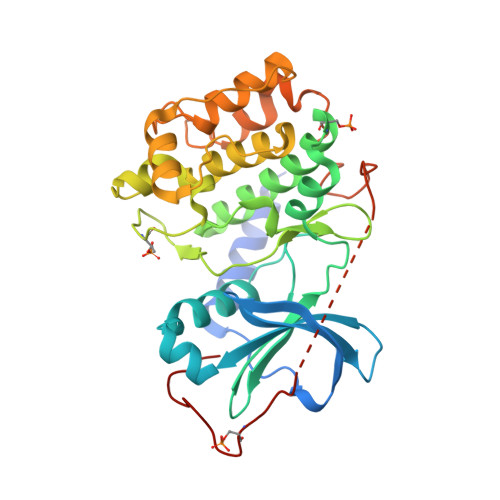The protein kinase C inhibitor bisindolyl maleimide 2 binds with reversed orientations to different conformations of protein kinase a.
Gassel, M., Breitenlechner, C.B., Koenig, N., Huber, R., Engh, R.A., Bossemeyer, D.(2004) J Biol Chem 279: 23679-23690
- PubMed: 14996846
- DOI: https://doi.org/10.1074/jbc.M314082200
- Primary Citation of Related Structures:
1SZM - PubMed Abstract:
As the key mediators of eukaryotic signal transduction, the protein kinases often cause disease, and in particular cancer, when disregulated. Appropriately selective protein kinase inhibitors are sought after as research tools and as therapeutic drugs; several have already proven valuable in clinical use. The AGC subfamily protein kinase C (PKC) was identified early as a cause of cancer, leading to the discovery of a variety of PKC inhibitors. Despite its importance and early discovery, no crystal structure for PKC has yet been reported. Therefore, we have co-crystallized PKC inhibitor bisindolyl maleimide 2 (BIM2) with PKA variants to study its binding interactions. BIM2 co-crystallized as an asymmetric pair of kinase-inhibitor complexes. In this asymmetric unit, the two kinase domains have different lobe configurations, and two different inhibitor conformers bind in different orientations. One kinase molecule (A) is partially open with respect to the catalytic conformation, the other (B) represents the most open conformation of PKA reported so far. In monomer A, the BIM2 inhibitor binds tightly via an induced fit in the ATP pocket. The indole moieties are rotated out of the plane with respect to the chemically related but planar inhibitor staurosporine. In molecule B a different conformer of BIM2 binds in a reversed orientation relative to the equivalent maleimide atoms in molecule A. Also, a critical active site salt bridge is disrupted, usually indicating the induction of an inactive conformation. Molecular modeling of the clinical phase III PKC inhibitor LY333531 into the electron density of BIM2 reveals the probable binding mechanism and explains selectivity properties of the inhibitor.
Organizational Affiliation:
Department of Pathochemistry, German Cancer Research Center, 69120 Heidelberg, Germany.

















